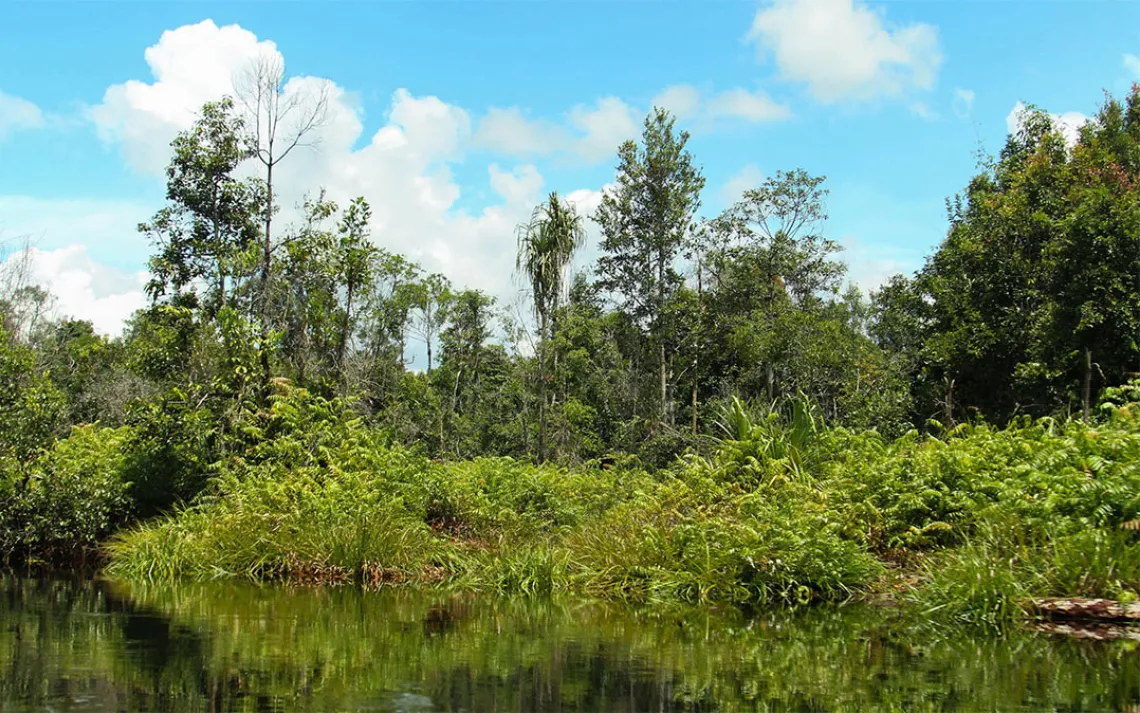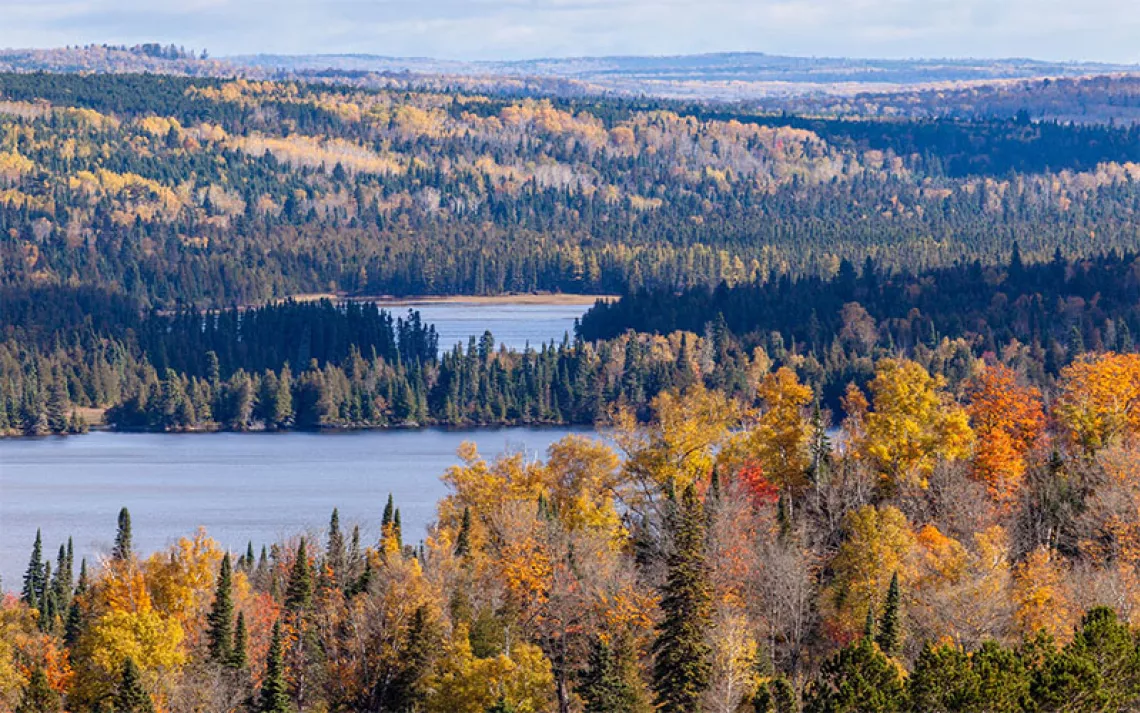Indonesia Wants to Protect Its Peatlands—But First It Needs to Figure Out Where They Are
How the Indonesian Peat Prize hopes to create a new standard in peat-mapping technology

Peat swamp forests of the Katingan Peatland Reserve, in Central Kalimantan, Indonesia | Photo by James Anderson, World Resources Institute
Today is World Wetlands Day, which commemorates the 1971 adoption of the intergovernmental Convention on Wetlands and serves to raise awareness about the importance of wetlands.
With President Trump’s talk of “draining the swamp,” you’d think wetlands are nothing more than a nasty stain on the landscape. But they’re actually host to an array of species and are crucial to helping us cope with extreme weather events, which are increasing in frequency due to climate change. And, come October, they’ll be a real moneymaker for the scientists who win the Indonesian Peat Prize.
The winners of the prize stand to make a substantial contribution to both mapping technology and conservation, helping to save one of the world’s littlest-known and funniest-named ecosystems.
Peatlands are wet environments that contain layers of partly decomposed plant material, and can be up to 100 feet deep. They cover only about 3 percent of the earth’s surface but store more than twice as much carbon as all of the world’s forests combined. So, in a nutshell, one way to slow climate change is to protect peatlands.
But preserving peatlands has so far proved challenging in Indonesia, whose economy is tied up in the agro-forestry industry. As of 2014, palm oil was the country’s second-largest export; it’s also been one of the biggest threats to peat.
An estimated 20 percent of palm oil plantations in Indonesia and Malaysia are grown on peat soils, and those soils must first be drained in order to be developed. Dry peat is highly flammable—peatland fires can rage for days or weeks—and when it catches fire, it releases all of its stored-up carbon and other harmful gases into the atmosphere, posing a health risk for local populations and wreaking havoc on the global climate. The palm oil industry is known to drain peatlands and intentionally light fires in order to clear land to grow oil palm.
Indonesia was ravaged by fires during the 2015 El Niño, which marks Indonesia’s annual dry period. Fires are an annual occurrence in Indonesia, but in 2015 they were especially horrific, raging for several months and pumping a thick cloud of smoky haze over Southeast Asia; there were reports of 500,000 cases of respiratory infections in the worst-affected parts of Indonesia, and a Harvard University study estimates that the fire and haze may have caused 100,000 premature deaths across the region.
One key problem has stood in the way of protecting Indonesia’s peatlands: No one knows exactly where they are.
“The maps that have been made are a best effort to map where peat is,” says Dr. David Schimel, senior research scientist at NASA’s Jet Propulsion Laboratory at the California Institute of Technology, “but they’re not very accurate, and they’re not very precise.” That’s because Indonesia’s peatlands are difficult to map.
“Most large-scale mapping techniques today rely on some sort of aerial photography or satellite remote sensing, or a combination of the two. But those techniques can’t see through [Indonesia’s] dense forest canopies,” says Schimel. “In areas where the forest is still relatively intact and pristine, there’s just intrinsically going to be less information. And so in the areas that you most want to protect, you have the least information.”
And so Indonesia’s Geospatial Information Agency—in partnership with the Packard Foundation, World Resources Institute–Indonesia, and the consulting firm Context Partners—launched the Indonesian Peat Prize. Launched on last year’s World Wetlands Day, the prize will award $1 million to the team that comes up with the most accurate and affordable technology to map Indonesian peatlands.
Last summer, the prize’s Science Advisory Board selected 11 teams out of 44 to advance to the development and demonstration stage of the prize. The teams hail from 10 countries spanning four continents.
The winning technology needs to produce maps that are far more detailed than existing ones. “What we have now is peatland extents at a scale of 250,000”—1 centimeter on the map represents 2.5 kilometers—"which is not that detailed,” says Dr. Nirarta Samadhi, country director for World Resources Institute–Indonesia, which is administering the prize. Also, “it’s not just a matter of knowing the peat extent, but we also need to identify the depth of the peatland,” since the deeper the peatland, the more carbon it stores and the more vital it is to protect.
To be sure, the Peat Prize will not save all of Indonesia’s peatlands; a map cannot reverse years of peatland destruction or force compliance with regulations (unrestricted slash-and-burn is technically illegal in Indonesia, but it’s still rampant). But—in combination with the government’s December ban on peatland development—it is a vital step toward a more sound conservation policy.
“The government has enacted regulations concerning its peatlands,” says Schimel, who co-chairs the prize’s Science Advisory Board, “and they can only enforce them if they know where the peat is.”
The prize could also result in the development of a new and improved standard in peat-mapping technology. Were it not for the prize, scientists might not have incentive to create this technology. “Prizes are a great mechanism to focus human energy and capital to solve a specific problem,” says Robert Q. Benedict, account manager for Prizes and Networks at Context Partners, which designed the Peat Prize. “It’s sort of like a lens that focuses sunlight on a very specific area. . . . [Prizes] create supply and demand where there is none, to solve a problem that desperately needs attention.”
Members of the prize committee are excited not only by the Peat Prize’s potential to develop peat-mapping technology, but also for future conservation innovations it may inspire.
“[The Peat Prize] is a very different approach to developing environmental management, which has typically been . . . either governmental or consulting-firm-oriented,” says Schimel. “We’re all excited about it. We hope it will work, we believe it will work, and we’re sure that we’ll learn lessons from how it works.”
 The Magazine of The Sierra Club
The Magazine of The Sierra Club






